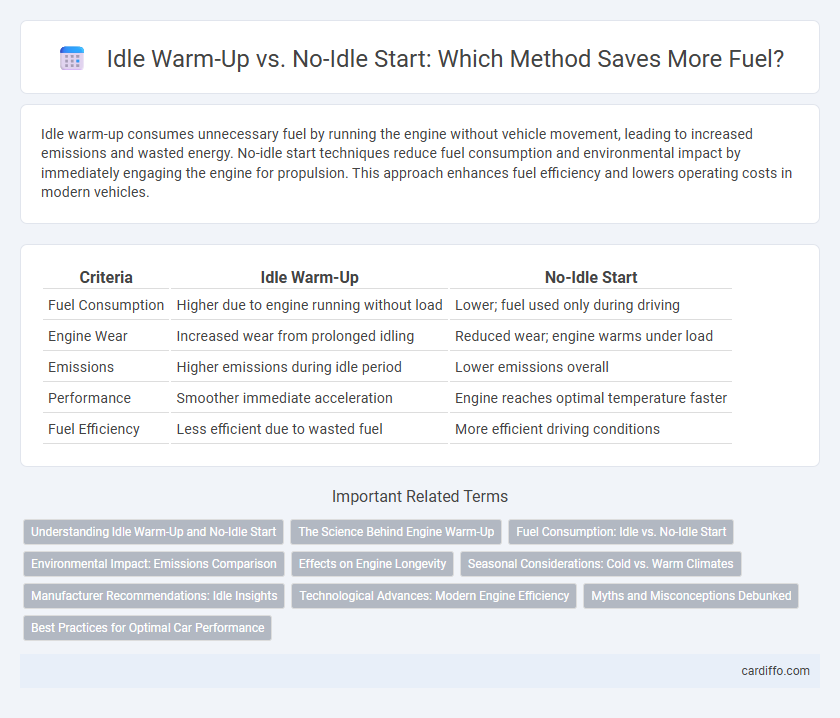Idle warm-up consumes unnecessary fuel by running the engine without vehicle movement, leading to increased emissions and wasted energy. No-idle start techniques reduce fuel consumption and environmental impact by immediately engaging the engine for propulsion. This approach enhances fuel efficiency and lowers operating costs in modern vehicles.
Table of Comparison
| Criteria | Idle Warm-Up | No-Idle Start |
|---|---|---|
| Fuel Consumption | Higher due to engine running without load | Lower; fuel used only during driving |
| Engine Wear | Increased wear from prolonged idling | Reduced wear; engine warms under load |
| Emissions | Higher emissions during idle period | Lower emissions overall |
| Performance | Smoother immediate acceleration | Engine reaches optimal temperature faster |
| Fuel Efficiency | Less efficient due to wasted fuel | More efficient driving conditions |
Understanding Idle Warm-Up and No-Idle Start
Idle warm-up involves running the engine at low RPM before driving to ensure optimal engine temperature and lubrication, improving performance and fuel efficiency. No-idle start eliminates this phase, immediately engaging driving mode, which can reduce fuel consumption and emissions but may increase engine wear in cold conditions. Understanding the trade-offs between idle warm-up and no-idle start is essential for optimizing fuel use and engine longevity in various climates.
The Science Behind Engine Warm-Up
Engine warm-up relies on the principle that fuel combustion efficiency improves as the engine reaches its optimal operating temperature, reducing unburned fuel emissions during idle warm-up. Modern fuel injection systems adjust air-fuel mixtures precisely, minimizing fuel consumption and engine wear even without prolonged idling. Scientific studies show that avoiding extended idling and starting the engine directly leads to faster temperature stabilization, conserving fuel and decreasing particulate emissions.
Fuel Consumption: Idle vs. No-Idle Start
Idle warm-up consumes significantly more fuel compared to no-idle start strategies, as the engine runs without performing work, leading to wasted fuel during extended idling periods. No-idle start methods immediately engage the drivetrain, optimizing fuel efficiency by reducing unnecessary combustion time. Studies show that avoiding idle warm-up can decrease fuel consumption by up to 20%, contributing to lower emissions and cost savings.
Environmental Impact: Emissions Comparison
Idle warm-up generates higher emissions due to prolonged engine operation without movement, significantly increasing carbon monoxide (CO), nitrogen oxides (NOx), and particulate matter (PM) output. No-idle start reduces fuel consumption and decreases overall greenhouse gas emissions by immediately engaging the engine in driving conditions. Studies indicate that eliminating idle warm-up can lower urban air pollution and carbon footprint by up to 20%.
Effects on Engine Longevity
Idle warm-up allows oil to circulate and engine components to reach optimal operating temperature, reducing wear caused by cold starts. Skipping idle warm-up with no-idle start strategies can increase engine stress due to insufficient lubrication and thermal expansion, potentially shortening engine lifespan. However, modern engines with advanced fuel injection and synthetic oils are better equipped to handle no-idle starts without significantly impacting engine longevity.
Seasonal Considerations: Cold vs. Warm Climates
In cold climates, idle warm-up is essential to ensure optimal engine performance and reduce wear by allowing the fuel to vaporize and lubricants to circulate properly before driving. No-idle start strategies are more effective in warm climates where engines reach operational temperatures quickly, minimizing unnecessary fuel consumption and emissions. Seasonal adjustments to idle warm-up and no-idle start practices can significantly enhance fuel efficiency and engine longevity across varying temperature conditions.
Manufacturer Recommendations: Idle Insights
Manufacturers recommend following specific idle warm-up times to optimize engine performance and fuel efficiency, emphasizing that modern engines require minimal idling before driving. Idle warm-up can lead to unnecessary fuel consumption and increased emissions compared to no-idle starts, which engage the engine immediately to operating temperature through load and driving conditions. Understanding these insights helps drivers balance fuel economy with engine longevity by adhering to manufacturer guidelines tailored to their vehicle model.
Technological Advances: Modern Engine Efficiency
Technological advances in modern engine efficiency have significantly improved fuel consumption during idle warm-up by optimizing fuel injection and ignition timing to reduce emissions and fuel use. No-idle start systems leverage sensors and variable valve timing to minimize engine warm-up time, cutting unnecessary fuel waste while maintaining performance and reducing wear. These innovations collectively enhance fuel economy by ensuring engines operate closer to optimal temperatures faster, decreasing overall fuel consumption during startup phases.
Myths and Misconceptions Debunked
Idle warm-up is often believed to improve engine performance and longevity, but modern engines typically require only minimal or no idling to reach optimal operating temperature, which conserves fuel and reduces emissions. No-idle start technology immediately utilizes fuel injection upon ignition, debunking the myth that engines need prolonged idling to lubricate components or prevent damage. Studies show that excessive idling contributes to unnecessary fuel consumption and increased wear, contradicting the misconception that idling preserves engine health.
Best Practices for Optimal Car Performance
Maintaining optimal car performance requires balancing idle warm-up and no-idle start strategies to reduce fuel consumption and engine wear. Short idling periods allow engine oil to circulate fully, preventing premature wear, while minimizing unnecessary idling helps decrease fuel usage and emissions. Implementing manufacturer-recommended idle times paired with efficient driving habits ensures both engine longevity and fuel economy.
Idle Warm-Up vs No-Idle Start Infographic

 cardiffo.com
cardiffo.com